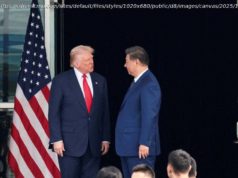In what the United States is calling an “unprofessional intercept, ” Chinese jets belonging to the People’s Liberation Army Air Force intercepted a U. S. Air Force plane designed to…
In what the United States is calling an “unprofessional intercept, ” Chinese jets belonging to the People’s Liberation Army Air Force intercepted a U. S. Air Force plane designed to detect radiation signatures consistent with nuclear tests. The WC-135 was operating over the East China Sea on Wednesday, May 17 when it was met by the two Chinese fighters.
A similar maneuver was portrayed in the film with Tom Cruise’s character, Maverick, piloting an F-14A Tomcat and flying inverted over a fictional Russian Mig-28 on a routine intercept.
While unorthodox, the interception isn’ t completely without precedent. There are numerous stories in the fighter jock world of U. S. pilots executing outlandish maneuvers when performing intercepts of Russian planes and vice-versa. Just last year, a Russian Su-27 did a barrel roll over a US RC-135 reconnaissance plane, the second in two months.
The WC-135 has the code name of “Constant Phoenix.” It is based on the frame of a Boeing C-135. Its mission profile is to collect samples from the air in order to detect and identify radioactive isotopes. The radioactive isotopes that the Constant Phoenix finds are produced during a nuclear detonation. Its common nickname among aviators and Air Force personnel is the “nuke-sniffer.” The United States Air Force only has two of these planes in operation, and they are only deployed in times of nuclear incidents.
The East China Sea is south of the Koreas. Prevailing winds in the area flow from the Siberian plateaus down through North Korea and into the East China Sea. That makes this area the best place for the WC-135 to detect any trace of radiation and isotopes from any nuclear detonations that have taken place in North Korea lately.
Previously, the WC-135s have been deployed to the area near Chernobyl and Fukushima Dai-ichi after the nuclear plant disasters. Recently, a Constant Phoenix was deployed near the Russian border in an attempt to discover why there was a high concentration of Iodine-131 was detected near the Norwegian-Russian border.
The Su-30 is a two-seat multirole fighter designed by Sukhoi and manufactured by KnAAPO and the Irkut Corporation in Russia. It has been in service since 1996 and remains one of Russia’s premiere combat fighters. The Su-30 has a maximum speed of Mach 2.0, with a range of just over 1,600 nautical miles. It’s NATO callsign is the Flanker-C.
The fighter craft has two engines with a thrust vector control system that enables the Flanker-C to perform very advanced maneuvers. The high speed and integrated fly-by-wire system combine to make the fighter extremely dangerous in the hands of a capable pilot. The Flanker is not just in service in Russia and China; other air forces with the Su-30 or variants of the fighter include Algeria, India, Indonesia, Malaysia, and Venezuela. There are two primary variants of the Su-30. One has forward canards – the little wings just forward of the primary wings; the other sacrifices these for an increased missile payload.
The Flanker is considered a fourth-generation fighter, comparable to the F-15, F-16, and F/A-18 jets in the United States Air Force. While the plane is aging and will soon be eclipsed by newer fifth generation fighters, there are only three fifth generation jets currently in service. These are the F-22 (US) , the F-35 (US) , and the Chengdu J-20 (China) . As such, the Su-30 remains a very dangerous adversary.
This isn’ t the first time that the U. S. and China have raised concerns on both sides due to air-to-air interceptions by PLAAF fighters. U. S. P-8 anti-submarine warfare planes are routinely intercepted over the South China Sea, with one incident seeing a J-11 coming within 30 feet of the U. S. plane before doing a barrel roll over the top of it. Interceptions will likely continue as the United States keeps its surveillance and pressure on North Korea to cease its quest for nuclear weaponization of ICBMs.
[Featured Image by Vadim Savitsky/Russian Defense Ministry Press Service/AP Images]






